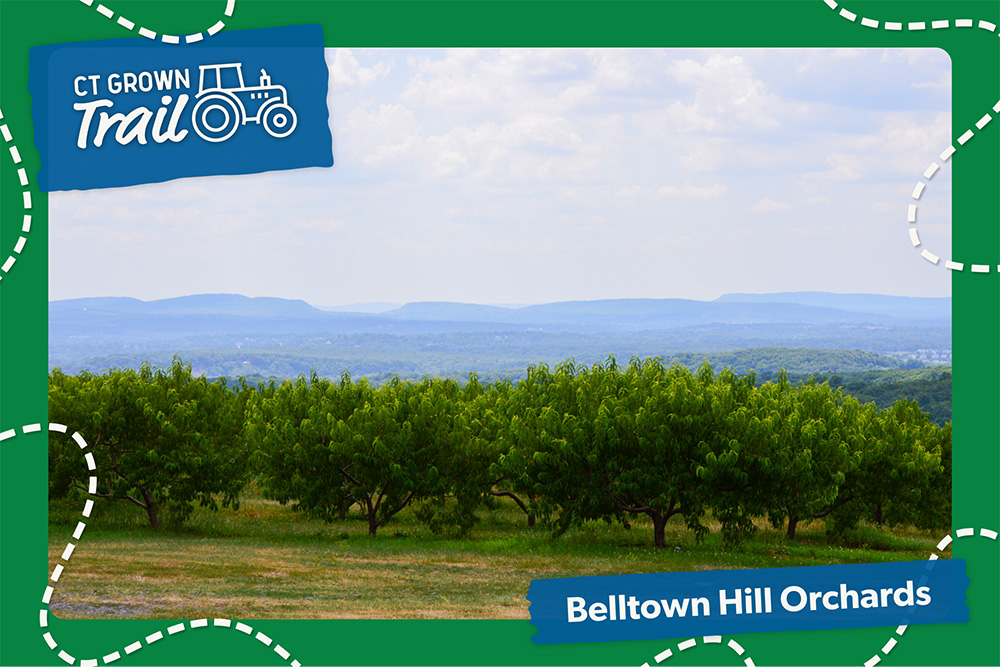
Come explore the delicious, locally produced food options available throughout Connecticut! Presenting the CT Grown Trail, uniting farm fresh food options, dining venues with locally sourced menu items, farmers’ markets, curated farm wine offerings, and more!
The CT Grown Trail provides suggestions for day trip itineraries allowing you to discover the diverse experiences available for finding locally sourced food. We invite you to review the itinerary for your region, and to continue exploring the fantastic opportunities for finding locally grown food in our state. Don’t forget to leave extra time for farm stands, locally produced ice cream, and other CT Grown attractions you may discover along the way!
Visit the CT Grown Trail to find more wonderful options and create your own journey. This blog offers suggestions for exploring the central region of Connecticut.
Morning
Breakfast
- Visit the Cafe at Clark Farms at Bushy Hill Orchard in Granby to enjoy breakfast favorites, such as their Apple Cinnamon Waffle made with their own apple cider, maple whipped cream, and fruit.
- Enjoy eggs, sausage, potatoes, and other goods sourced from Connecticut farms at BLDG in New Haven.
- Stop by Perk on Main in Middletown, which is committed to using local farms for its menu of crepes, breakfast sandwiches, and more.
Pick Your Own
- Visit Belltown Hill Orchards in South Glastonbury to make a selection of seasonal fruits including plums, peaches, blueberries, apples, and more. Make a stop at their market for other local farm fresh products and freshly baked apple cider donuts.
Afternoon
Lunch
- Enjoy a meal at The Beamhouse in Glastonbury, which has a strong commitment to local ingredients. Find offerings from local farms, breweries, wineries, coffee roasters, and other producers.
- Get a table at Zinc in New Haven, which takes a “seed to plate” approach emphasizing the use of locally sourced ingredients for globally inspired meals.
- Visit Cafe Routier in Westbrook, whose menu items are inspired by the seasonal offerings of local farms and producers.
Farm Visit
- Explore a selection of fresh corn, eggplant, peppers, and other seasonal produce at Treat Farm in Orange.
- Stop by Clover Nook Farm in Bethany for meat products, as well as fresh seasonal vegetables, maple syrup, and honey.
- Head over to Deerfield Farm in Durham to find milk, yogurt, cheeses, and other dairy products.
Greenhouse
- Swing by Geremia Greenhouse in Wallingford and find some amazing plants and cut flowers at their retail stand. Their specialties include orchids, flowering annuals, and vegetable and herb varieties.
Winery Tour
- Visit Rosedale Farms & Vineyards in Simsbury to try out handcrafted wines. As a farm winery, you can also discover fresh fruits and vegetables as well as special chef-to-farm dinners.
- Make a stop at Gouveia Vineyards in Wallingford. It’s a dog-friendly venue, which makes it the perfect location to sit and stay for awhile. Pack your own picnic or purchase a charcuterie board in the tasting room to enjoy with your wine.
- Head to Chamard Vineyards, a French-inspired winery and bistro in Clinton, for local wines and lunch fare featuring ingredients from local farms.
Farmers’ Market
- Pay a visit to the West End Farmers Market (open Tuesdays from June through September from 4-7 pm) in Hartford and meet with vendors selling fresh vegetables, fruits, flowers, prepared foods, and more.
- Check out one of three farmers’ markets managed by CitySeed, an organization promoting a local food ecosystem and sustainable agriculture in the New Haven area. Each one is a producer-only market, meaning all the items for sale were grown on the vendor’s farm.
- Visit the Middletown Farmers Market to find fresh produce, flowers, and more from local farmers.
Evening
Dinner
- Grab dinner at Millwright’s Restaurant in Simsbury, which sources ingredients from several farms and producers around Connecticut. Guests can enjoy a local beer at the tavern or a view of the beautiful natural surroundings from the dining room.
- End your day with a meal at Arturo’s Restaurant in Branford, featuring Mexican fusion dishes made with locally sourced ingredients.
- Dine at River Tavern in Chester and find an ever-changing seasonal selection based on the latest items available from farmers and producers.

Come explore the delicious, locally produced food options available throughout Connecticut! Presenting the CT Grown Trail, uniting farm fresh food options, dining venues with locally sourced menu items, farmers’ markets, curated farm wine offerings, and more!
The CT Grown Trail provides suggestions for day trip itineraries allowing you to discover the diverse experiences available for finding locally sourced food. We invite you to review the itinerary for your region, and to continue exploring the fantastic opportunities for finding locally grown food in our state. Don’t forget to leave extra time for farm stands, locally produced ice cream, and other CT Grown attractions you may discover along the way!
Visit the CT Grown Trail to find more wonderful options and create your own journey. This blog offers suggestions for exploring the eastern region of Connecticut.
Morning
Breakfast
- Enjoy a hearty breakfast at The Farmer’s Cow Calfe & Creamery in Mansfield, featuring breakfast sandwiches with locally sourced eggs and meats as well as beverages featuring milk from Connecticut dairy farms.
- Stop in at The Vanilla Bean Cafe in Pomfret, featuring creative menu options made with ingredients sourced from local farms.
- Visit Somewhere in Time in Mystic, known for its filling fare featuring farm-fresh ingredients.
Visit a Farm
- Make a stop at Foster Hill Farm in Stafford Springs, where you will find over 170 varieties of tomato and pepper plants, plus herbs, perennials, vegetable plants, and miniature donkeys.
- Browse the general store at Our Kids Farm in Canterbury to find handmade, homemade, and locally sourced products including eggs, meat, milk, cheese, ice cream, jam, and maple syrup. When you are done shopping, go visit their Nigerian Dwarf goat herd and horses!
- Pay a visit to Sweet Grass Creamery in Preston to find dairy products like milk, yogurt, and cheese. Their farm market also features several products from other local farmers, such as jams, honey, and maple syrup.
Afternoon
Lunch
- Make a reservation at Monet’s Table Restaurant, located in an 18th century farmhouse, and experience local ingredients in salads, savory sandwiches, lunch entrees, and more.
- Visit Stone Row Kitchen + Bar in Willimantic, whose menu offerings are driven by the latest products available from local farms and seafood producers.
- Get a table at Oyster Club in Mystic, which specializes in local foods like fresh caught fish, dry aged meats, and CT Grown vegetables.
Vineyard Tour
- Visit Cassidy Hill Vineyard in Coventry to sample a wine flight, wine slushie, or a traditional glass of white or red. Enjoy live music on the lawn on Fridays between May and September.
- Grab a beer or a glass of wine, tour the vineyard, and listen to live music at Taylor Brooke Winery and Brewery in Woodstock. Check their website for scheduled food trucks and special “meet the winemaker” events.
- Stop by Priam Vineyards in Colchester, a veteran-owned winery, to enjoy a delicious glass of wine as well as live music and other special events.
Visit an Oyster Farm
- Head to the shore to see Stonington Farms Shellfish, a small family oyster farm. Give them a call ahead of time and they’ll have a fresh order ready for you to pick up!
Farm Stand
- Stop by The Farm Stand at Lemek Farm in Tolland for fresh fruits and vegetables, salsa, sauces, goat’s milk soap, and other goods including hanging baskets with seasonal flowers.
Farmers’ Market
- Visit the Putnam Saturday Farmers Market (Saturdays from 10 a.m. to 1 p.m., June through October) to shop fresh produce and local goods.
Evening
Dinner
- Book a reservation at The Shipwright’s Daughter in Mystic, where executive chef David Standridge received the 2024 James Beard Award for Best Chef in the Northeast! This restaurant places value on sustainability, sourcing ingredients like kelp, fish, and vegetables from local farmers and producers.
- Dine at The Tavern at Spring Hill at Mansfield, part of an inn located in an 18th century building, for an extensive menu featuring local ingredients.
- Browse the menu at 85 Main in Putnam, which prides itself on menu items using freshly sourced seafood and produce from local farms.
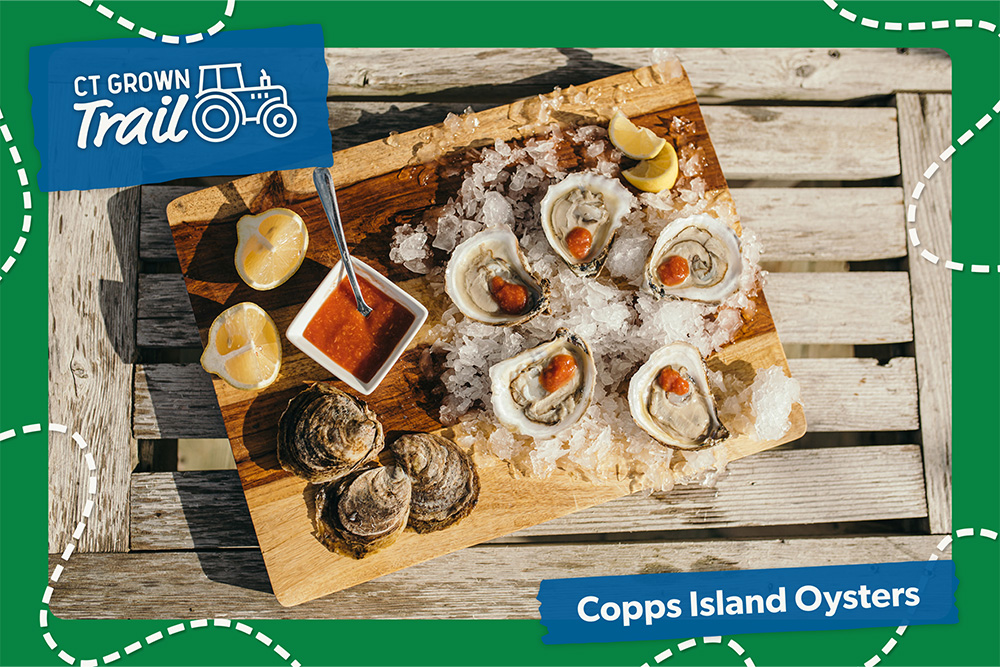
Come explore the delicious, locally produced food options available throughout Connecticut! Presenting the CT Grown Trail, uniting farm fresh food options, dining venues with locally sourced menu items, farmers’ markets, curated farm wine offerings, and more!
The CT Grown Trail provides suggestions for day trip itineraries allowing you to discover the diverse experiences available for finding locally sourced food. We invite you to review the itinerary for your region, and to continue exploring the fantastic opportunities for finding locally grown food in our state. Don’t forget to leave extra time for farm stands, locally produced ice cream, and other CT Grown attractions you may discover along the way!
Visit the CT Grown Trail to find more wonderful options and create your own journey. This blog offers suggestions for exploring the western region of Connecticut.
Morning
Breakfast
- Have a farm-fresh breakfast at the Milk and Honey Grill in Goshen, known for its locally sourced products. Enjoy a delicious selection of breakfast sandwiches and other delicious fare to get ready for the day ahead.
- Enjoy a farm-to-table brunch at Terrain Garden Cafe in Westport, a greenhouse eatery featuring hand-picked local dishes.
Visit a Farm
- Visit March Farm in Bethlehem. Pick your own fresh fruits and berries, get a selection of produce at the farm stand, take the kids to enjoy a farm-themed playscape, and watch the goats clamber over a climbing course in their pondside yard.
- Stop by Laurel Ridge Farm in Litchfield to pick up some cuts of grass-fed beef and pastured pork products.
- Head to Sport Hill Farm in Easton to peruse its selection of fresh eggs, seasonal produce, and carefully curated local goods.
Farmers’ Market
- Start your day at the Danbury Farmers’ Market (Saturdays 10 a.m. to 2 p.m., June through October) for fresh produce, local goods, and health and nutrition programs.
Afternoon
Lunch
- Load up on picnic supplies at the Bantam Bread Company, which features artisan breads, rustic pastries, and a wide range of locally produced goods like butter, cheese, and honey.
- Have lunch at Bailey’s Backyard in Ridgefield, which is committed to finding fresh, high-quality meats, seafood, and produce from local producers.
Winery Tour
- Visit Hopkins Vineyard in Warren, head to the wine bar in the hayloft of a 19th century barn, and relax with a glass of the latest vintage as you gaze over nearby Lake Waramaug.
- Head to Jones Family Farms & Winery in Shelton and pick from a wide selection of wine options.
Evening
Dinner
- Make a reservation at The Community Table in New Preston. This restaurant is committed to using locally sourced ingredients and updating its menu regularly to feature in-season items. Stop in on Mondays for a special burger night!
- Visit the Copps Island Oyster Shack, with locations in Stratford and Norwalk, to enjoy delicious oysters, clams, and other seafood straight from local boats.

Interested in exploring more of Connecticut’s fantastic farm wineries? Participate in the 2024 Passport to Connecticut Wine Country program to create lasting memories and explore all that Connecticut has to offer!
The Passport will be available starting on May 4th, 2024. Participants can pick up a printed book at participating farm wineries, or download the digital app on the Apple App Store or Google Play. Both the printed book and app can be obtained free of charge.
The Passport program offers visitors the opportunity to engage with Connecticut’s award-winning farm wineries and be entered into prize drawings. At each stop, Passport holders can receive a physical or digital stamp, which counts as one point toward a reward level. Upon reaching a reward level, the Passport holder is entered into a drawing for that prize.
More than 100 prizes will be available, valued at a total of over $10,000. The three reward tiers are:
🍷 Taster (12 or more stamps)
🍷 Sommelier (18 or more stamps)
🍷 Winemaker (35 or more stamps)
Anyone who visits all 38 participating locations will be eligible for a commemorative gift recognizing their support of Connecticut’s farm wineries. Up to 50 names will be drawn at random for this prize.
Two locations are making their debut in the Passport program this year: Independence Vineyard in Lebanon and Tranquility Vineyard Winery in Middlebury.



The 2024 Passport program will conclude on December 31st, 2024. The prize drawing will be held no later than January 31st, 2025.
Only one entry is allowed per person. Stamps between printed books and the digital Passport cannot be combined.
The Passport is a program of the Connecticut Farm Wine Development Council, a voluntary council made up winery owners, research institutions, and representatives of Connecticut
Department of Agriculture and Connecticut Department of Economic and Community Development. The council, which is administered by the Connecticut Department of Agriculture, is responsible for promoting state wines and related products, offering educational programs, recommending research projects, and advising groups on farm wine development.
When people commit to supporting CT Grown farmers, they usually do so by purchasing more locally grown foods — signing up for a CSA, shopping at a farmers’ market, or even just looking for food from Connecticut farms at the grocery store.
There’s also a way to directly support CT Grown agriculture, right from your own home: establishing a pollinator garden. Taking this action not only supports Connecticut’s floriculture sector, but also benefits the animal pollinators that are crucial for the state’s produce farmers.
The importance of pollinators

Pollination, or the transfer of pollen grains between the male and female parts of a flower, is necessary for the fertilization of many plants. Once this process occurs, the plant will be able to develop fruits, vegetables, seeds, and nuts.
Some plants are able to use wind-borne pollination or self-pollination, but the most—including the majority of CT Grown crops—rely on animal pollinators. Since animals directly seek flowers for their nectar, they provide a reliable and productive way of pollination. Animal pollination also helps create a more diverse plant population and higher crop yields.
Bees are an important pollinator, and there are more than 300 native bee species in Connecticut that help to create vibrant local agriculture. Other important pollinators include butterflies, moths, hummingbirds, and certain species of flies, beetles, and wasps.
Pollinator-friendly plants

Animal pollinators are facing numerous challenges, with factors such as development, deforestation, and invasive plants threatening their habitats. When you establish a pollinator garden at your home, you help to create a space that can support them. The more pollinator gardens that are established, the easier it is for animal pollinators to find the resources necessary for them to thrive.
Flowers that are well-suited for attracting pollinators in Connecticut include:
- Bee balm: This plant doesn’t just attract bees, but butterflies and hummingbirds as well! It comes in a variety of colors, including vibrant shades of red, pink, or purple.
- Buttonbush: Well-suited for wetter conditions, buttonbush produces unique globe-like flowers.
- Columbine: With their long, spurred shape, columbine flowers are a favorite of hummingbirds.
- Geranium: A shade-tolerant perennial that commonly comes in purple and magenta.
- Goldenrod: A late season bloomer that produces bright yellow flowers.
- Highbush blueberry: White flowers attract pollinators in the spring, and yield tasty fruit in the summer!
- New England aster: Produces showy summer flowers in pink, purple, and white.
- New Jersey tea: A drought-tolerant plant that produces white flowers in mid-summer.
- Swamp milkweed: A native wildflower beloved by monarch butterflies.
Several vegetable plants also have flowers that attract pollinators. These include squash varieties, which produce large yellow flowers; bean varieties, which have white or purple flowers; and edible flowers such as borage or sunflowers.
Best practices for pollinator gardens
- Don’t worry about size: A four-by-four foot plot works well as a pollinator garden, and you can always expand it later. You can also simply update an existing flower or vegetable garden, or create a series of small garden patches using methods like containers or window boxes.
- Use a range of plants: For the best results, use a diverse mix of at least three to five plants that bloom at different times of the year. This strategy provides a consistent source of nectar and pollen from early spring through late fall.
- Find companion pairings: Some flowers will help support your vegetable garden by attracting pollinators, and may even help repel pests. Some good pairings include borage and tomatoes, nasturtiums and squash, and basil and peppers.
- Use native plants: Native plants are already adapted to local soil and climate conditions, so they require less maintenance.
- Remove invasive plants: Invasive plants can crowd out native plants that pollinators rely on for sustenance; remove them to help native plants thrive.
- Create simple habitats: Features such as hollow logs, patches of bare earth, bee houses, and a shallow birdbath help sustain pollinators and provide them with shelter.
- Avoid pesticides or herbicides: Pesticides and herbicides can kill pollinators or impede their reproductive or navigational abilities. Use natural products to minimize these harmful effects.
Helpful programs and resources
- University of Connecticut Extension: Offers resources on native plants and sustainable landscaping to support pollinators.
- Connecticut Agricultural Experiment Station: Provides helpful reports and fact sheets on supporting local pollinators, including A Citizen’s Guide to Creating Pollinator Habitat in Connecticut.
- Pollinator Pathway: A Connecticut-based organization dedicated to restoring and connecting pollinator habitats, with information on native plants, landscape management, and more.
- The Xerces Society for Invertebrate Conservation: Includes resources for creating pollinator-friendly habitats suited to a variety of landscapes.
- The Connecticut Audubon Society: Maintains pollinator gardens at several of its properties, and shares resources about their management. Learn more with the “Getting Started with Native Plants” guide and the Bird & Pollinator Garden at Deer Pond Farm in Sherman.
Spring arrives slowly but surely in Connecticut. Daffodils and tulips begin to poke up from the thawing ground, and crocuses begin to appear alongside melting snow. Dogwoods and forsythia burst into bloom, adding welcome hues to the landscape. And all across the state, homeowners rush to prepare their lawns and gardens for the warmer weather.
Connecticut has a robust number of farmers raising flowers, shrubs, and other plants that can help you breathe new life into your landscape, create enticing displays within your home, and add beauty to your special occasions. Spring is a busy time for these producers, who make up the largest share of Connecticut’s agriculture.
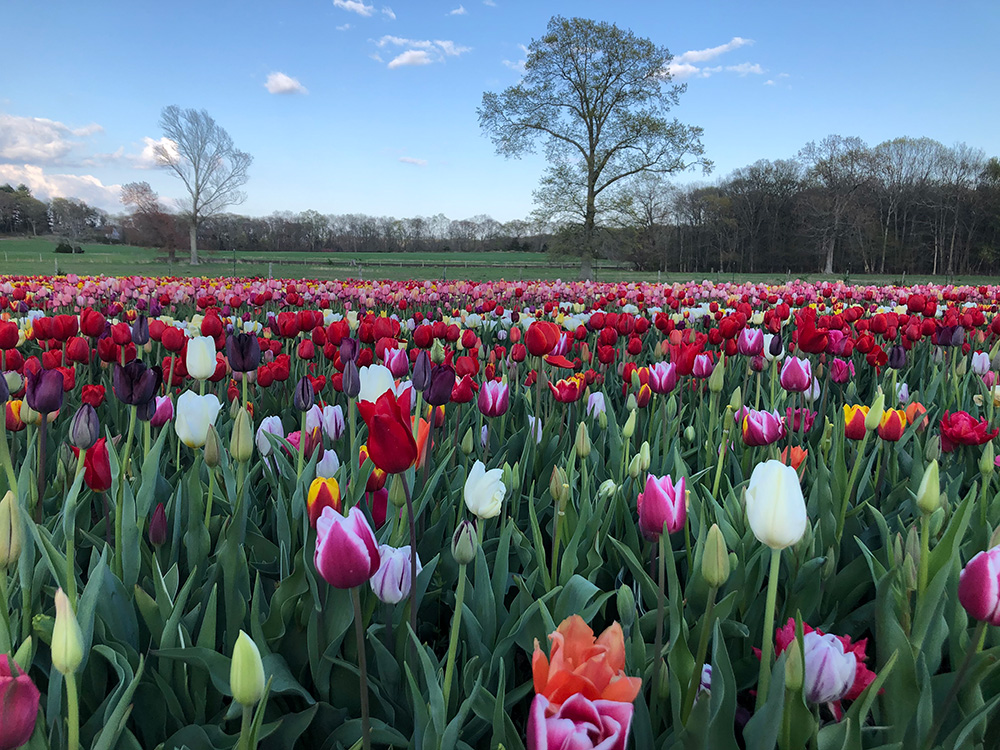

In this blog, we explore how Connecticut’s greenhouses, nurseries, farms, and garden centers are excellent places to visit during the spring. Whether you’re looking to improve your home or simply want a memorable experience, you’ll find something that’s right for you.
Greenhouses, nurseries and garden centers
Throughout the winter, Connecticut’s greenhouse and nursery producers have been busy sowing seeds, potting plants, and preparing to assist customers in the new growing season. By visiting a CT Grown greenhouse or nursery, you’ll receive:
- Expert guidance: Whether you’re trying to liven up a shady spot or need advice on growing a specific plant, greenhouse and nursery producers can offer expert advice and care plans tailored to your own property.
- Educational opportunities: The spring season often brings workshops and other educational opportunities at greenhouses and nurseries. Attendees can learn about seed starting, container gardening, composting, and much more.
- Great deals: To encourage people to pursue the big plans they have for their garden, nurseries and landscapes may offer discounts or open up loyalty programs at the beginning of the spring season. Take advantage of these to enjoy savings throughout the year.
- New inspirations: A visit to a garden or nursery can inspire a new vision for your home. Discover new plant options and features that can transform your rooms or landscaping.
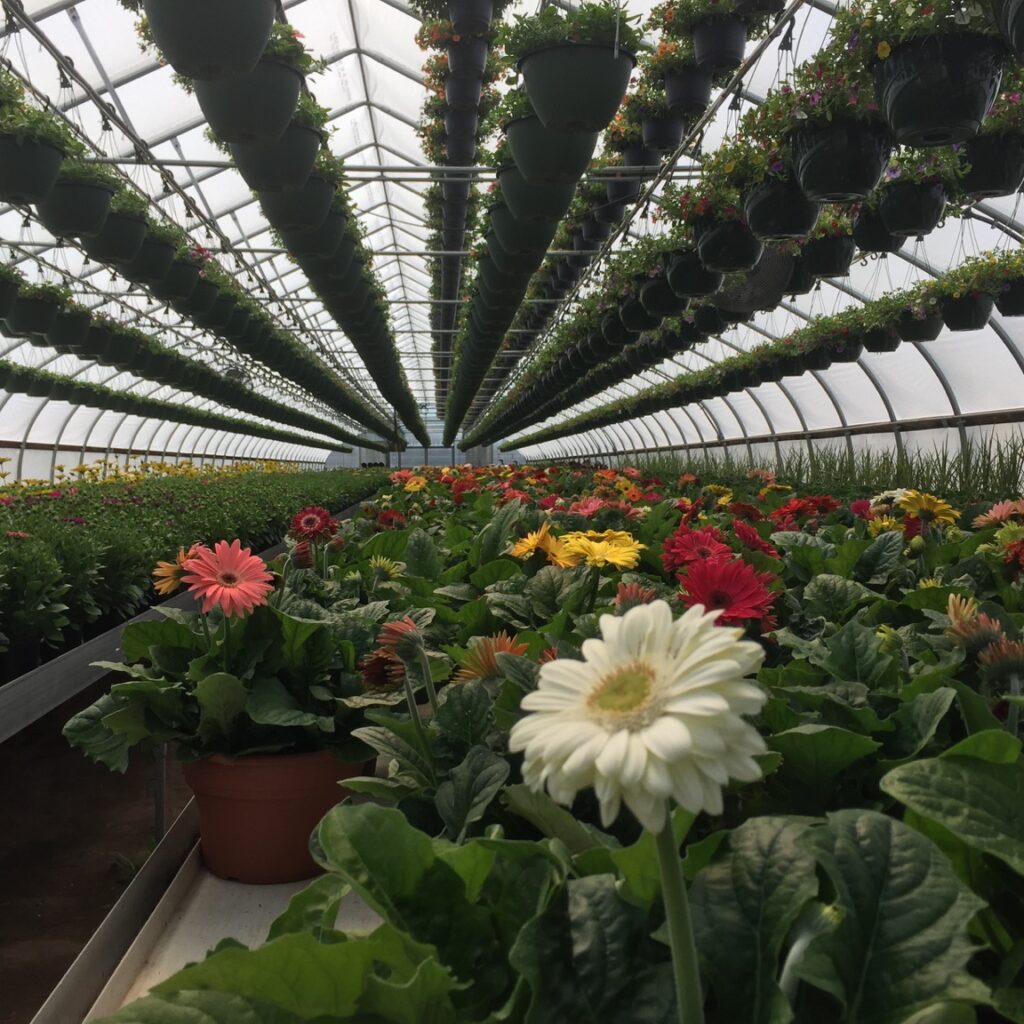
There’s no shortage of products available at greenhouses and nurseries to get a jump on the year’s gardening plans, including:
- Annual flowers: Although annuals only last a single season, they add a welcome pop of color to your garden and are easy to care for. Some of the annuals available in spring include Easter lilies, impatiens, marigolds, pansies, and petunias.
- Perennial flowers: Perennials return year after year, making them an easy option for long-term garden planning. Some spring perennial choices include coneflowers, daylilies, and hostas.
- Shrubs: A useful choice for boundaries or privacy barriers, shrubs can also create beautiful landscaping and support pollinators when you choose flowering varieties like butterfly bushes, hydrangeas, and viburnums.
- Fruiting trees: Add a small orchard alongside your vegetable garden using varieties like apple and cherry trees.
- Vines: Transform vertical surfaces into part of your garden using vining plants like clematis and honeysuckle.
- Vegetable starts and seedlings: Plants that have been sown indoors — including eggplants, herbs, peppers, and tomatoes — let you get a jump on the year’s harvest.
Walk-through flower experiences
Some farms in Connecticut give visitors an up-close look at the returning floral landscape by offering walk-through experiences. Visitors can stroll through the fields and marvel at the spectacle of thousands of flowers in bloom together.
In a relaxing, meditative experience, visitors are surrounded by the visual beauty and delightful scents of a sea of flowers. These scenes are also a popular photographic backdrop for everything from family portraits to engagement shots.


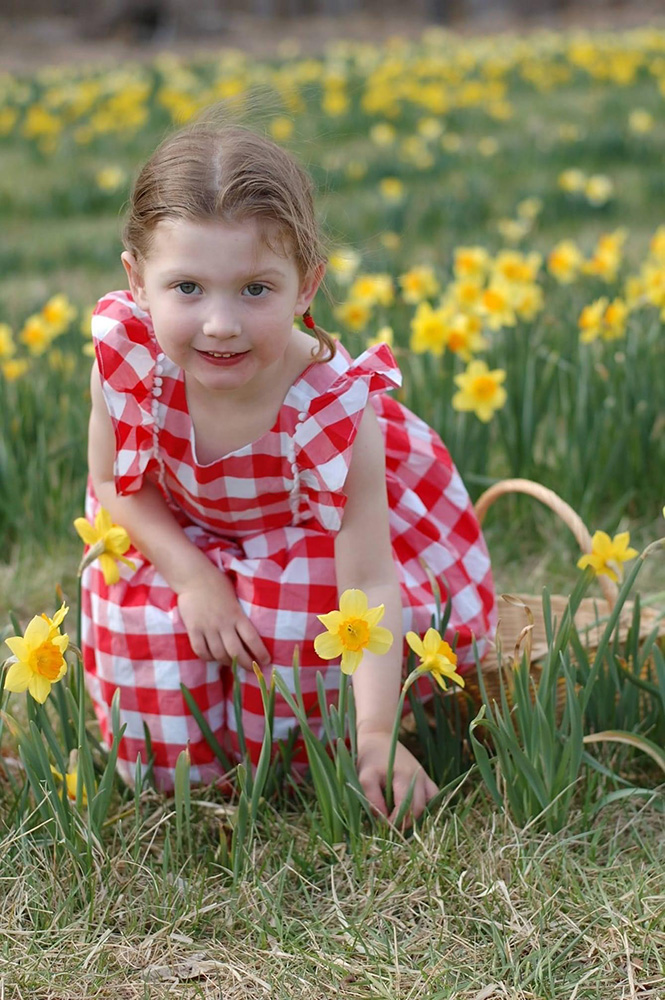
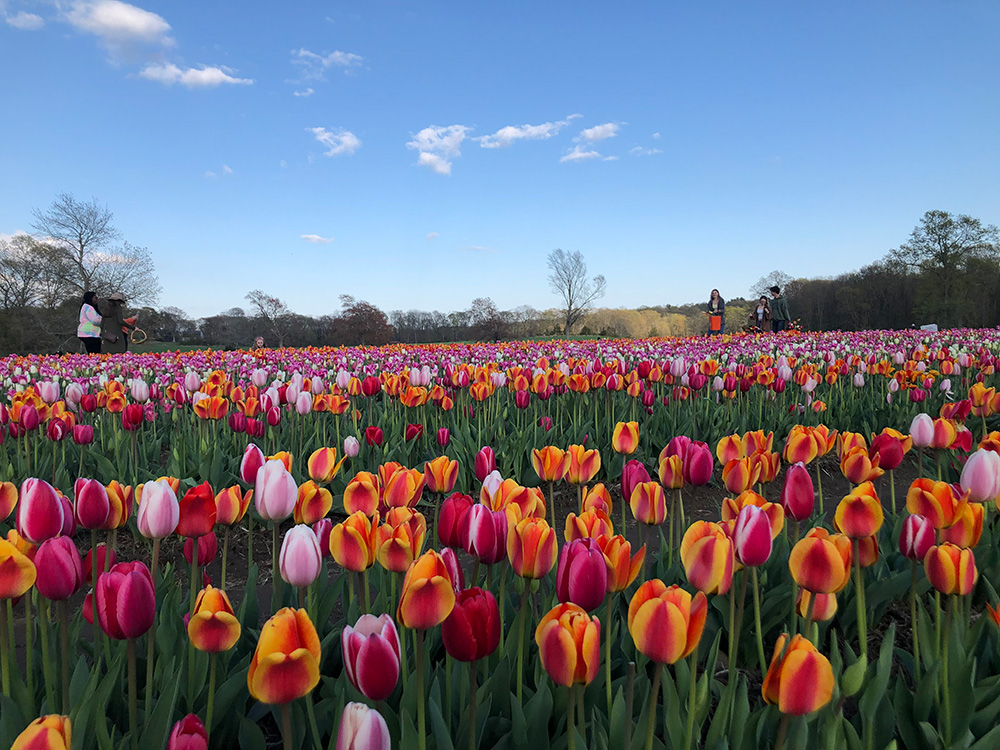
Walk-through flower experiences are often paired with pick-your-own options that let you take home a beautiful bouquet. Some options in Connecticut include:
- Halfinger Farms (Higganum): Every year, “Dancing Daffodils” at this farm lets visitors visit a field of these brilliant yellow flowers and pick their own selection. Halfinger Farms hosts several special events alongside the daffodil season, while also raising additional flowers such as peonies, violas, and mums.
- Lavender Pond Farm (Killingworth): Denise Salafia established this farm as a tribute to her mother, who died of breast cancer. Today, it invites visitors to walk through the fields as thousands of lavender plants come into bloom.
- Wicked Tulips (Preston): One of three locations growing a total of more than 1.5 million tulips, Wicked Tulips gives visitors the one-of-a-kind experience of walking through a vast field of these flowers during their brief but awe-inspiring time in bloom.
- Willow View Farm (West Suffield): Along with thousands of ornate dahlias, this farm lets visitors pick a selection of varieties that include daffodils, peonies, and tulips.
Cut flower CSAs
Community Supported Agriculture (CSA) programs go well beyond the traditional shares of fruits and vegetables, and Connecticut’s thriving floriculture businesses mean that there are plentiful options to find cut flower CSAs. Farms may offer these options either on their own or as an optional add-on to another CSA.

Spring flower CSAs are an excellent choice for people who can’t wait to get fresh flowers back into their home after a long winter. These feature seasonal flowers such as alliums, anemones, canterbury bells, daffodils, hyacinths, narcissus, ranunculus, and tulips. Farms often grow specialty varieties that aren’t usually found in stores, allowing each farm to create bouquets with a distinctive look.
Cut flower CSAs continue into summer and autumn, with each new share changing based on what’s in season. Some farms may also offer these CSAs into the winter, featuring greenhouse-grown flowers.
To find a cut flower CSA near you, visit the CT Grown map.
The new harvest season will be here before you know it, and there’s still time to sign up for a CT Grown CSA! By joining a Community Supported Agriculture program this winter, you’ll receive regular shares of fresh, nutritious food for months to come.
Read more about your CSA options in our latest newsletter, or visit one of these resources to learn more:
- CT Grown CSAs: A Win-Win for Farmers and Consumers
- Meat, Flowers…Seaweed? Explore CT Grown’s Non-Traditional CSA Options
- CT Grown Map: Find a CSA Near You
It’s a season for families to come together and celebrate the holiday spirit. And when everyone from the grandparents on down to little grandchildren are together under one roof, that means it’s time for another big feast!
CT Grown products are a great choice for the family gathering. You’ll also need something to wet your whistle, though, and Connecticut’s farmers have you covered there as well! Check out these options, and raise a glass to CT Grown for the holiday season!
Eggnog

Like many traditional holiday dishes or beverages, eggnog was once considered a luxury due to the priciness of many of its ingredients. Families would splurge on the drink — and other delicious items — and hold toasts to wealth and prosperity in the new year.
Although eggnog is no longer considered a luxury, these toasts have remained — along with the seasonal availability of the beverage, which could conceivably be offered year-round. Eggnog is a thick, sweet drink that mixes milk, cream, sugar, egg yolks, and whipped egg whites.
Several Connecticut dairy farms get in on the holiday spirit by producing eggnog at this time of year. You can enjoy it plain, or spike it with alcohol like rum or bourbon.
This is also the only time of year you can test it out in other ways! Try eggnog as a coffee creamer, or use it as a milk substitute in recipes for waffles, pancakes, and cookies.
Coquito

Spanish for “little coconut,” coquito is also referred to as Puerto Rican Eggnog due to its popularity on the island. As a tropical tradition, many of its ingredients — including coconut milk, coconut cream, and vanilla — aren’t exactly CT Grown.
However, you can still use yolks from locally sourced eggs and mix them with condensed milk (a product invented in Connecticut, incidentally) to make a thick base for this drink. Add in some rum from a Connecticut distillery as well!
Whiskeys and spirits

A growing number of distilleries in Connecticut are giving residents and visitors a local option when it comes to bourbon, gin, rum, vodka, whiskey, and other spirits. These distilleries frequently partner with local farms to infuse their product with flavors like fruit and herbs.
During the holiday season, you can relax with warming drinks like a hot toddy, hot buttered rum (using CT Grown butter, of course), spiked hot chocolate, or a nor’easter — a winter spin on the Moscow Mule that includes maple syrup in the mix.
Wine
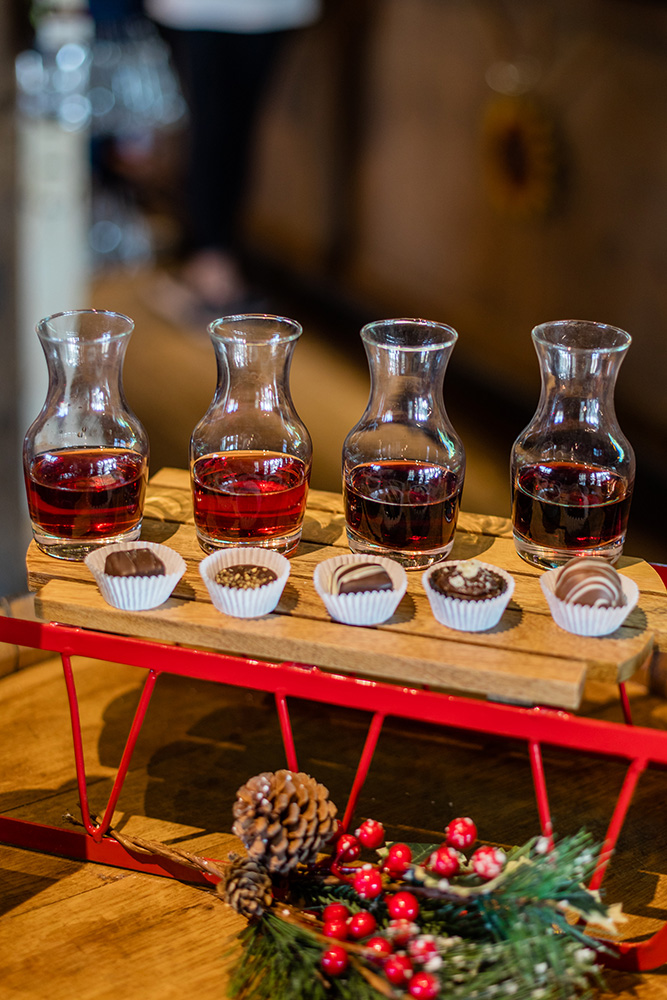
Some of Connecticut’s 45 farm wineries close their doors for the season when colder temperatures arrive, but many are happy to welcome guests throughout the year. Pull up a seat in the cozy tasting room to enjoy some delicious vintages, and pick up a bottle or two as a gift.
Connecticut farm wines also work well for mulling to create a delicious, warm beverage on a holiday evening. Mulled wine is prepared with ingredients like oranges, honey, and spices for a wonderful evening libation.
Wassail

Yes, the drink from the Christmas song!
Traditionally held on Twelfth Night, wassailing involves a group of people visiting homes to sing festive tunes and wish the occupants good cheer. The homeowner rewards them with a small gift (a figgy pudding, perhaps) in exchange for the group’s blessings and a drink from the bowl of wassail they carried. In addition to the neighborhood strolls, wassailing ceremonies have also taken place in orchards to bless the trees before the next season.
Although caroling has largely replaced wassailing, the beverage remains a unique holiday offering — and one that can easily use CT Grown ingredients. Wassail is traditionally made with a base of cider, ale, or wine, which is then mulled with spices.
Beer

Connecticut’s craft breweries are in operation year-round. But once winter arrives and patrons abandon the beer garden for the toasty taproom, the preferred styles shift to heartier fare.
“Winter warmers” such as porters and stouts typically use darker malts, have a higher alcohol by volume (ABV), and are more filling. In addition, many breweries celebrate the season by creating holiday ales with ingredients like cinnamon, orange peel, and other flavors found in mulled drinks.
You may also find a greater availability of imperial beer options, which have stronger, heartier flavors that may be further enhanced through barrel aging. These beers also have a very high ABV, so be sure to drink responsibly.
Cider

This autumn favorite is still available during the holidays, though this is also your last call for the delicious beverage. Apple cider is a dark, sweet beverage produced by compressing apple mash; since it lacks preservatives, it has a shorter shelf life and more seasonal availability compared to apple juice.
Warm up with apple cider on a cold evening by mulling it with honey, maple syrup, or spices. You can also look for some of the hard cider options offered by many orchards, which often have varieties pairing the alcoholic beverage with flavors like honey and ginger.
Milk for Santa

You can’t forget Saint Nick this time of year. Locally produced milk is available from 87 dairy farms in Connecticut, and leaving out a glass of milk for Santa ensures that he’ll get 13 essential nutrients with every serving.
Thanksgiving is a time to get together with your loved ones, count your blessings for the good things in your life, and — of course — eat until you have to loosen your waistband.
The big meal is a centerpiece of Thanksgiving, a chance to pile the dining room table high with delicious food and share in the bounty. And as the benefits of locally sourced food become more well-known, there has been an increasing demand for farm fresh food to bring to the holiday table.
You can put CT Grown on your plate for every course of the Thanksgiving feast, from the main course to that extra slice of pie. Check out these recommendations for how to include CT Grown foods at this year’s get-together.
Turkey

More than 100 farms in Connecticut raise turkeys. These farms take pre-orders to prepare for the holiday and manage demand, so reserving your bird early is a good strategy.
When preparing a farm fresh turkey, be aware that it tends to be ready sooner than a store-bought turkey. That’s because a farm fresh turkey has a higher moisture content, allowing it to roast faster — and giving an unbeatable, succulent taste!
Roast for about 12 to 15 minutes per pound at 325 degrees. Monitor the turkey carefully, and check regularly about an hour before you expect that it will be finished. The turkey will be done when its internal temperature reaches 165 degrees.
Looking for a turkey alternative this year? Farms raising turkeys often have other poultry as well, such as chickens, geese, and ducks. You could even take home a few different birds to try your hand at a turducken!
Looking for different ways to use up Thanksgiving leftovers? Try turkey empanadas or a turkey tortilla soup served up with locally made cheese, chips, and salsa.
Stuffing
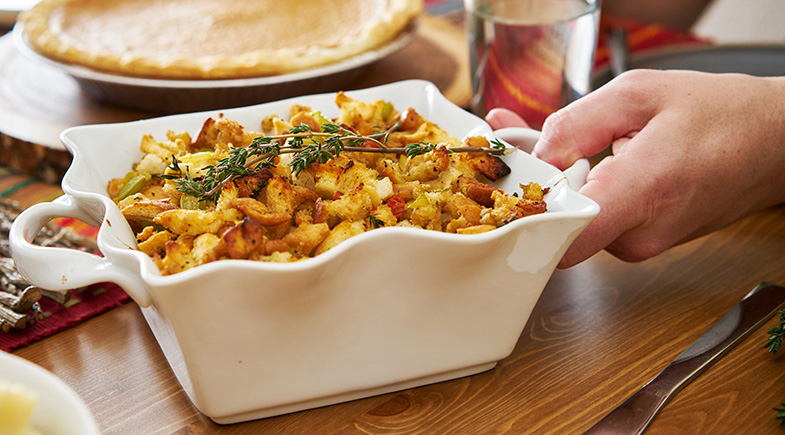
There are countless recipes for stuffing, so there’s plenty of room for creativity when it comes to this particular dish. Whether you’re using a cookbook recipe or one passed down through the generations, you can find plenty of the necessary ingredients at CT Grown farms. Some common options include sausage, mushrooms, onions, carrots, garlic, herbs, or apples.
Potatoes
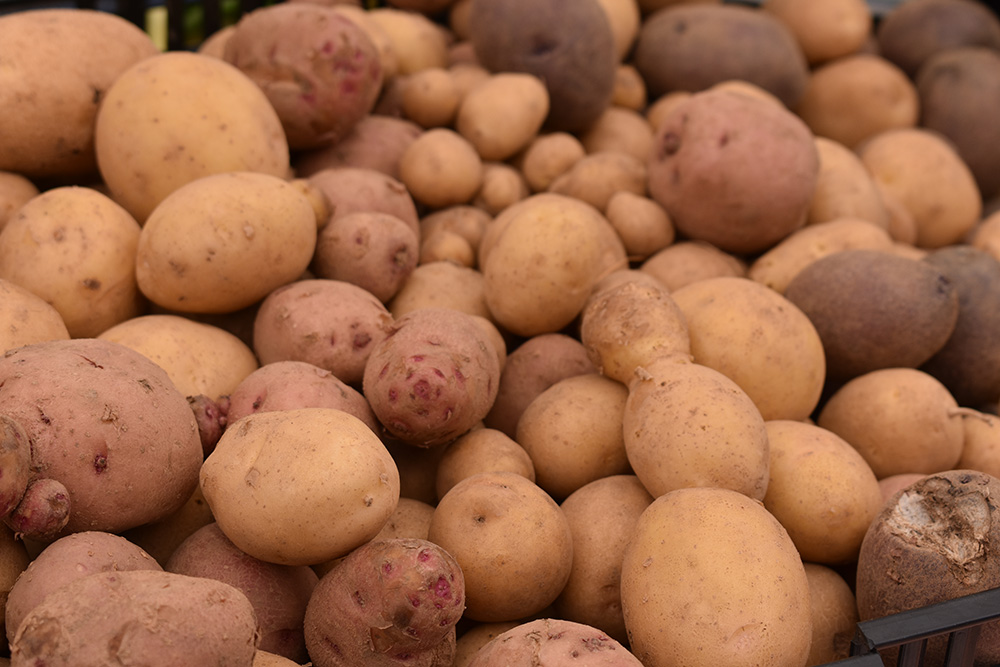
Potatoes are easy to grow and produce a bountiful harvest, so many CT Grown farms dedicate some of their land to this crop. Use some locally grown potatoes for the traditional favorite of mashed potatoes, or try a unique option like scalloped potatoes, potatoes au gratin, or a potato bake mixed with local vegetables.
Potato sides are often prepared with dairy products like milk, butter, or cheese. Choose products from one of Connecticut’s family dairy farms when purchasing these ingredients!
Side dishes
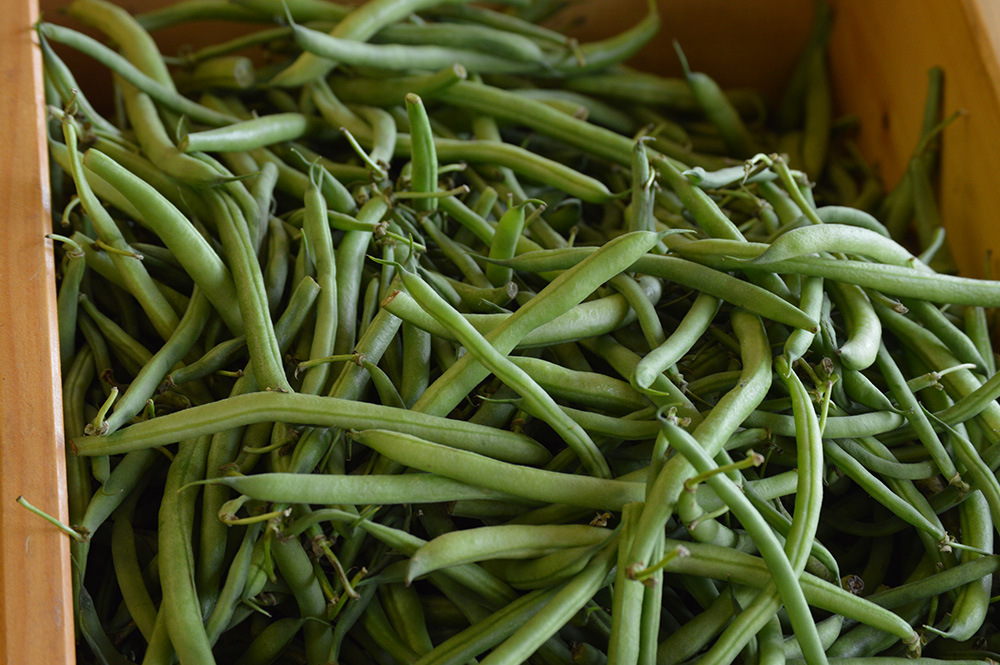
Sweet potatoes are always a hit at Thanksgiving dinner, but don’t overlook the many varieties of winter squash grown in Connecticut. Check out options like acorn, butternut, delicata, and spaghetti squash to try something new.
Plenty of greens are still in season, including green beans and Brussels sprouts. You can also find leafy greens, cucumbers, and tomatoes for a CT Grown side salad.
CT Grown farms can also be a good source of ingredients for dishes like Relleno de pavo, a sweet and savory stuffing made with ground meat, chorizo, bacon, apple, raisins, and more.
Cranberry sauce

Cranberries are a very minor crop in Connecticut. However, there is one commercial-scale cranberry bog operating in Killingworth and selling the resulting products locally.
If you want a local alternative — or supplement — to the traditional cranberry sauce, consider putting together some homemade applesauce. It’s a great way to use up some of the apples you get from an orchard!
Wine

Connecticut is home to more than 45 farm wineries, all offering delicious and unique vintages to pair with your Thanksgiving dinner. Have at least three options available for your guests: a white or rosé as a starter, a light- or medium-bodied wine for the main course, and a sweeter option like Riesling or port to go with dessert.
Desserts
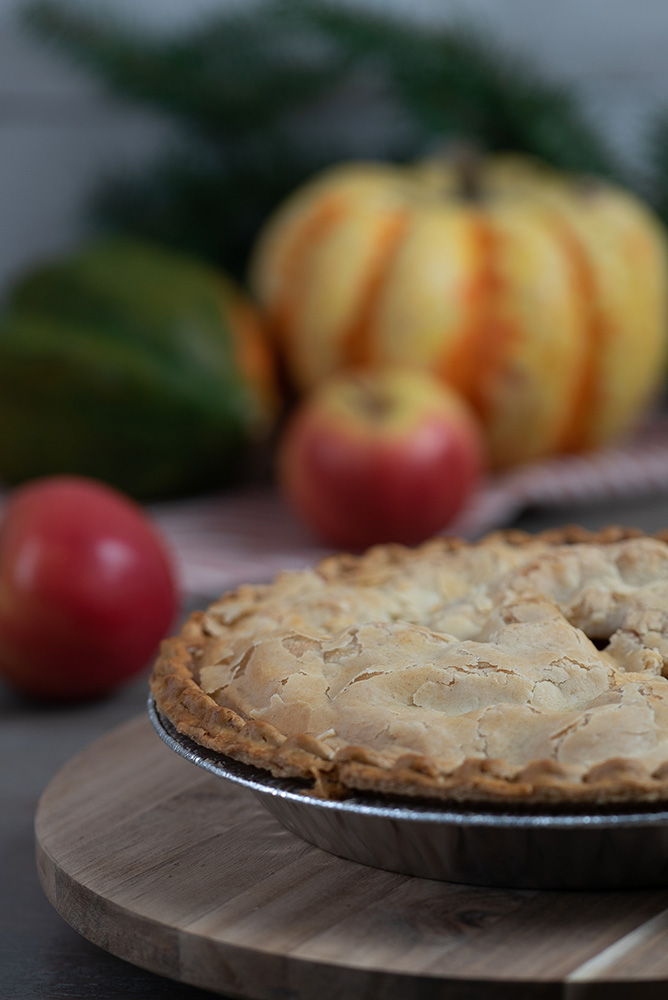
Prepare a few seasonal goodies in advance, and you’ll have some delicious desserts to enjoy once you’ve had a moment to digest. Visit an orchard to choose your own selection of apples to bake into scrumptious apple pie, bars, fritters, and other treats. And, if you are short on time, many offer “grab and go” prepared pies or other baked goods.
Connecticut’s dairy farms are a good source for dessert ingredients as well. Look for locally sourced cheese, ice cream, or whipped cream for a pie topping.
You can pick up a pumpkin to use for final courses like pie, cookies, cupcakes, or flan. Sweet potato pie also makes an excellent Thanksgiving dessert.
Flowers
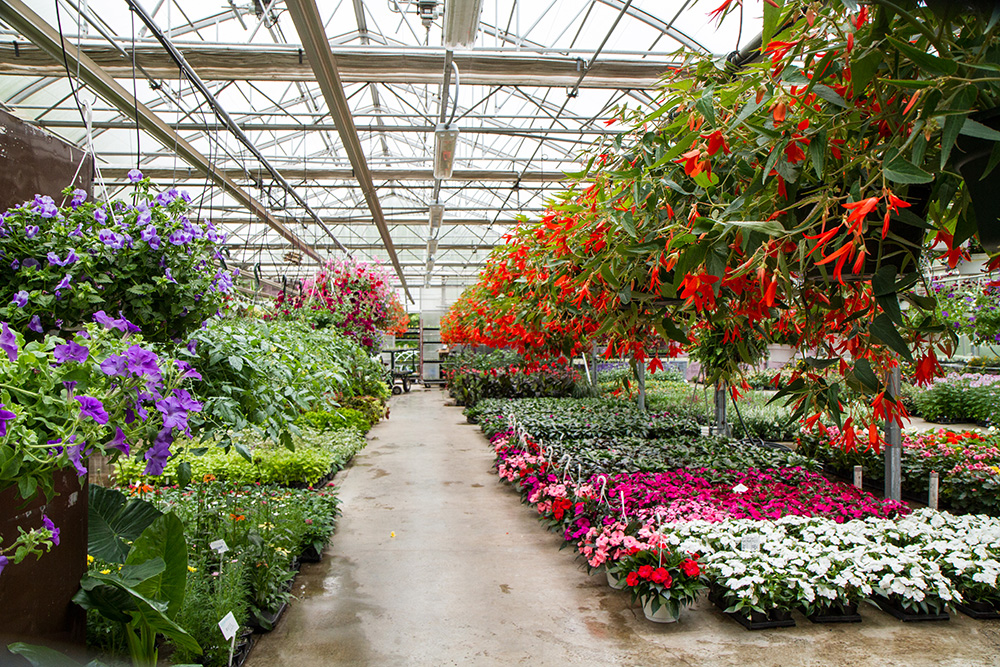
Last but not least, pick CT Grown for the floral arrangements you’ll have at the dinner table. Flowers are a major part of Connecticut agriculture, with the state ranking 9th in the nation in total greenhouse and nursery sales. Locally sourced flowers are easy to find at a Connecticut greenhouse, nursery, or garden center.
Look for flowers in yellow, orange, and red to evoke and celebrate the fall season. Some options include carnations, daisies, mums, roses, and sunflowers.
In honor of National Farmer’s Day, the Connecticut Department of Agriculture and Governor Ned Lamont are asking Connecticut residents to incorporate locally grown and produced items into every meal this fall
This fall, the Connecticut Department of Agriculture’s (CT DoAg) CT Grown program challenges consumers across the state to “Put CT Grown On Your Plate,” a new program that asks residents to make room on their plates for Connecticut-grown or produced foods at every meal.
This program serves as a reminder to all Connecticut residents that they have the opportunity to incorporate fresh, healthy, and delicious foods into their everyday diets while also supporting the state’s agriculture and aquaculture communities.
“When you eat food that was grown in Connecticut, you are not only getting a nutritious meal, but you are also supporting your neighbors who work in Connecticut’s agriculture industry,” Governor Ned Lamont said. “With more than a hundred farmers’ markets operating across the state and dozens upon dozens of stores selling locally grown food, everyone has the opportunity to support Connecticut farmers.”
Connecticut is home to more than 5,500 farms covering more than 380,000 acres. The state’s agriculture industry supports 22,000 jobs in production, processing, or agribusiness and contributes approximately $4 billion to the state’s economy each year. With more than 100 farmers’ markets operating across the state, Connecticut consumers have access to fresh, local foods year-round. Eating local foods supports farmers and growers, bolsters the state’s economy, and greatly benefits the general public health.
“Adding CT Grown foods to your meal plans is a great way to promote healthy eating habits while supporting our state’s diverse array of farmers and producers,” said Bryan P. Hurlburt, Commissioner of CT DoAg. “Incorporating these locally grown or made foods can be as simple as packing an apple or milk in your child’s lunch box or seeking out the CT Grown logo at your local grocery store or dining venue.”
Read 10 Ways to Put CT Grown Products on Your Plate Every Day
Through a pair of programs — Supplemental Nutrition Assistance Program (SNAP) and the Farmers’ Market Nutrition Program (FMNP), Connecticut Grown food products are accessible to families of all income levels and budgets.
The Connecticut Department of Agriculture strongly encourages people who receive SNAP benefits to use them at farmers’ markets. Most markets accept these benefits, allowing them to be used for the purchase of fruits, vegetables, cut herbs, and honey. Some markets help these benefits go even further by doubling benefits for fruit and vegetable purchases.
Most farmers’ markets in Connecticut are affiliated with FMNP, which serves participants of Women, Infants, and Children (WIC) and seniors over the age of 60 and meets income eligibility guidelines with funds through an app or card to purchase fresh fruits, vegetables, cut herbs, and honey. The FMNP program is accessible between July 1 and November 30 each year.